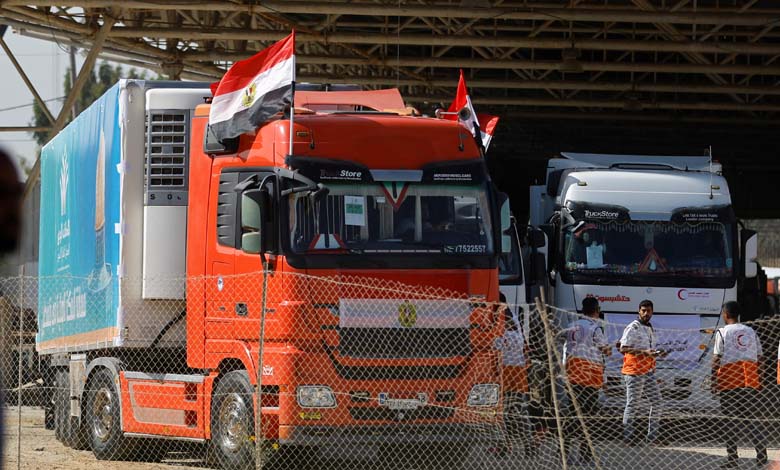Thousands in Gaza Face Famine as Aid Trucks Line Up in Egypt on Eid

The line of aid trucks stretches along the city of Rafah on the Egyptian side, awaiting Israeli approval to enter the Gaza Strip, which is on the brink of famine. On the occasion of Eid al-Fitr, the lineup of trucks reflects the daily struggle to feed Gaza during the war launched by Israel against the enclave.
Aid and Famine
According to the British newspaper, the majority of aid remains stuck on the Egyptian side, with most of Gaza’s population on the brink of famine due to Israeli obstinance.
It reported that the accumulation of trucks along a 4-kilometer stretch carries 14,000 tons of goods, equivalent to 19 million ready-to-eat meals. Clearing this backlog would take over three days at the usual rate of passage to Gaza. However, on bad days, relief workers say truck queues can stretch back to the Egyptian airport of El Arish, 50 kilometers from the border.
The report further stated that trucks can also be seen waiting at the southern border of Gaza with Israel at the Kerem Shalom crossing for inspection. However, humanitarian agencies say more aid is awaiting in warehouses in Egypt, pending Israeli approval.
The deadlock stems from grim realities, with only a small fraction of humanitarian aid able to enter Gaza or be distributed daily, far less than what relief agencies estimate Gaza needs.
Multiple Obstacles
According to the newspaper, several obstacles prevent trucks from reaching Gaza, including Israeli targeting of many of them, insecurity within Gaza, a shortage of security personnel, complex Israeli inspection procedures, few congested entry points, lack of delivery vehicles, and the countless tragedies of war.
It added that there are no quick solutions. Even Israel’s recent promise to open additional crossings, long demanded by the international community, will only address some issues.
The report emphasized that land crossings are the most efficient and cost-effective means of delivering aid, especially the crossing with Egypt. Israel announced that 322 trucks entered Gaza on Sunday, the highest daily total since the war began.
While relief groups welcomed this increase, which followed a warning from Joe Biden that continued U.S. support depends on efforts to alleviate humanitarian suffering in the enclave, the number is still below the minimum daily average of 500 that the United Nations says Gaza needs.
Dire Situation
The British newspaper confirmed that six months into the war, the humanitarian situation has become dire, especially as Muslims around the world celebrate Eid al-Fitr, coinciding with record levels of hunger crisis in Gaza, according to the Integrated Food Security Phase Classification (IPC), a UN advisory body.
Most of the 2.3 million inhabitants of the enclave have been forced to leave their homes, and the UN Supreme Court, the International Court of Justice, warned that famine has already “begun” in some areas and ordered Israel to ensure the immediate flow of aid “without hindrance.”
Israel denies preventing aid and rejected the ruling of the UN court, instead accusing Hamas of seizing supplies and blaming relief agencies for poor distribution. However, Israel’s arguments have found no credibility in the international community, which asserts that Israel is the main cause of the crisis.












